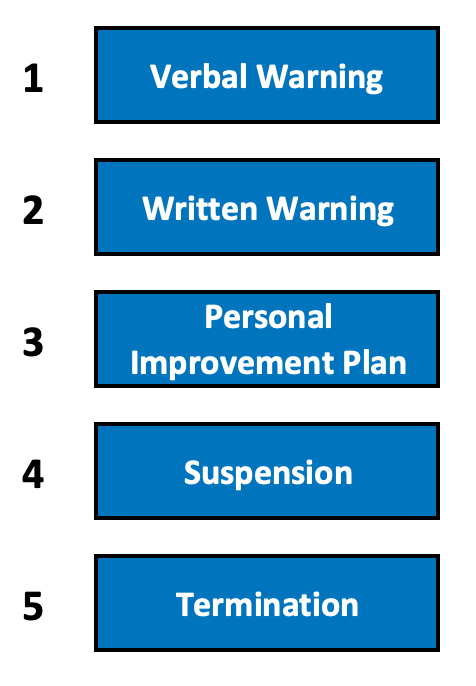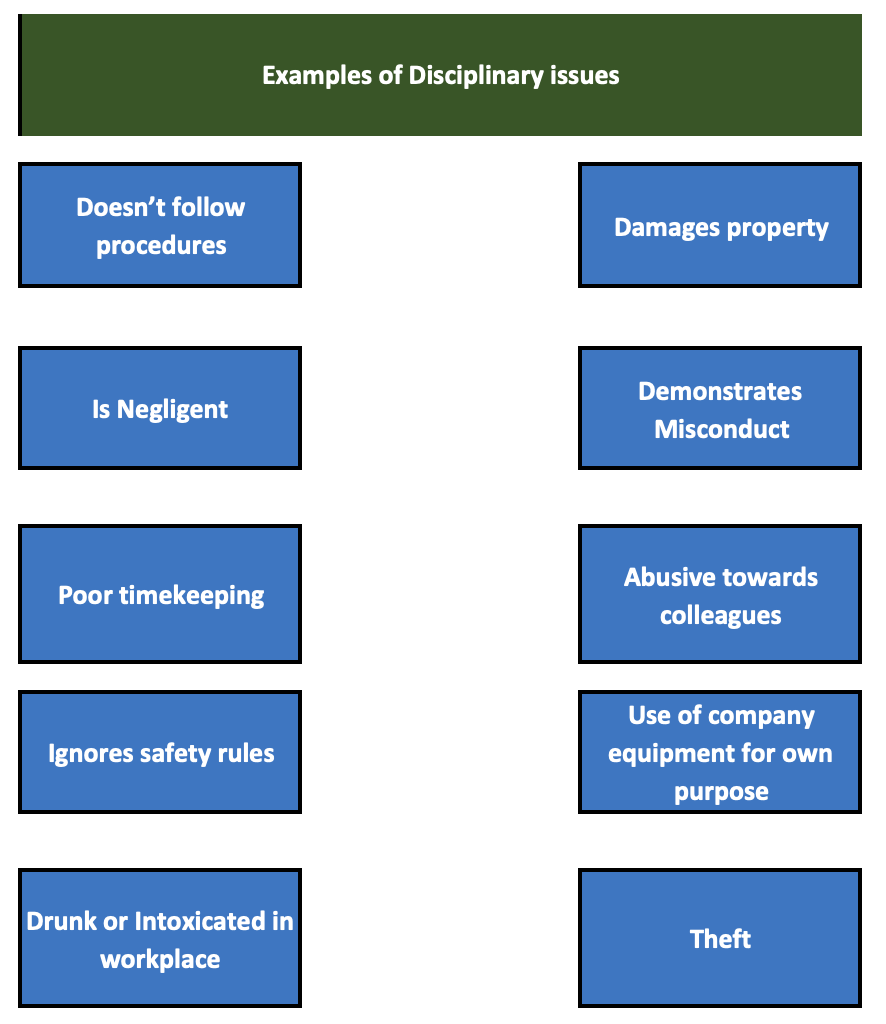
Progressive discipline is a methodology for managing people whose behaviors do not comply with organizational policies.
It is derived from a series of steps that
- Inform the employee of the issue
- Offer a level of consultation to discuss the issue, and what corrective actions can be made and are expected
- Offer a route for corrective action (typically through an improvement plan).
- Provide a pathway to terminate the employee if improvement is not obtained or behaviors are severe.
This article will review Progressive Discipline and how it is applied in business; we’ll be covering
- What is progressive discipline?
- The importance of a discipline policy
- Examples of disciplinary issues
- Progressive discipline steps
- Step 1 – Verbal Warning
- Step 2 – Written Warning
- Step 3 -Performance Improvement Plan
- Step 4 – Suspension
- Step 5 – Termination
- How to implement Progressive Discipline
- Benefits of Progressive Discipline
- Issues with Progressive Discipline
What is progressive discipline?
While organizational policies and documentation will typically outline expectations, merely documenting requirements is not enough.
Where employees fall below expected standards, a process is required that looks to
- Provide structure around administrating underperforming employees
- Provide clear communication to the employee
- Provide a route to correction
- Provides appropriate discipline where the issues recur and/or of a severe nature.

Many businesses use progressive discipline to manage divergence from expectations; progressive discipline is a process that:
- Uses a graduated system
- Looks to inform employees where issues or behavior fall below expected standards
- Provides employees opportunities to improve
- For minor /moderate issues, it doesn’t invoke severe disciplinary action early on
- Give employees ample opportunity & support to improve performance and or behavior before more severe disciplinary action is taken.
- Uses standard tools like performance improvement plans
Progressive discipline is usually supported by an organizational policy (or set of policies) and reinforces expectations that have been established in organizational documents such as:
- The business management system
- Procedures
- Manuals
- Employee Agreements & Handbooks
The importance of a discipline policy
Disciplinary rules are critical to establish standards, communicate and reinforce to employees what is acceptable and what is not.
Companies that lack a discipline policy expose themselves to:
- A lack of a standard process
- General failure to take action before issues progress
- Reduced focus on support & corrective actions
- Increased pressure on decision-makers/managers
- Potential legal claims
- Non-compliance against legal requirements
It’s important to remember that rules, procedures, and policies are not there to frighten employees but are there to inform them. Procedures communicate standards that must be achieved in the workplace.
Disciplinary procecdures also provide a standard set of tools for organizational leadership and management to deal fairly with employees who may have breached rules or not met standards.
While many people may associate discipline with termination, let’s not forget that the key driver behind most progressive discipline policies is to show where employees have not met standards and help them change in order to be compliant.
Finally, as we stated earlier, a published discipline policy/procedure is a legal requirement in some countries/regions.
Examples of disciplinary issues
Let’s look at some examples of breaches in discipline to provide some context around the process; common breaches include:
- Refusal to follow instructions or procedures
- Damage to property
- Negligence
- Misconduct with customers or suppliers
- Poor timekeeping
- Verbal abuse or bullying of colleagues
- Breaches of safety rules
- Unauthorized use of company facilities or equipment
- Being drunk or intoxicated in the workplace
- Theft

Progressive discipline steps
Most progressive discipline policies are built around a five-step model.
While the input into the process is actions or behaviors, there are some variables:
- Severity – is this a minor or severe breach of expectations (which may drive steps or speed of process).
- Frequency – is this a one-off or consistent occurrence.
Let’s now look at each step in detail:
Step 1 – Verbal Warning
Verbal warnings are often as a result of:
- A first ‘offense.’
- Minor issue/breach of rules
While the warning is verbal, managers must follow the documented formal procedure, which both provides a guide as to what to do and is also there to legally protect the organization.
A meeting is usually called between the manager and the employee to review the matter; discussion typically includes:
- The nature of the issue
- Expectations over standards
- What improvement is required (note this sometimes includes a level of counseling over how improvement can be reached)
- A verbal warning over what might happen should that standard not be achieved.
A written report of the verbal warning, including:
- Information relating to the issue,
- Remedial action required,
- The timescale discussed for improvement etc
This written report is for record-keeping only and does not constitute a written warning.
Step 2 – Written Warning
A written warning follows if the manager has noted that despite a verbal warning, performance has not improved to the required standard.
The written notice includes:
- Confirmation of the issue
- Relevant elements from the verbal warning.
- What changes are required (i.e., what standards need to be met and by when)?
- What will happen if changes are not achieved.
- Actions likely to be taken in the event of further misconduct
- How long the written warning is in force (i.e., 12 months).
- What support will be offered from the organization.
- How long the written notice will be in effect on their personal file.
In most organizations, this letter originates from the Human Resources function and may quote evidence from step 1.
A meeting with the employee may or may not take place prior to the issuing of the letter.
Step 3 -Performance Improvement Plan (PiP)
The use of a PiP is common practice in many organizations. In some, it will happen after the verbal warning; in others, it will happen after the written warning; most follow the same basic pattern:
- A PIP is a formal written plan/document.
- It outlines perceived performance issues,
- It provides the employee targets or goals to drive the improvements required.
- It is usually timebound (i.e., 12 months)
- Performance may be monitored.
- Over a single duration (i.e., all goals complete within three months)
- Several stages – (30% of goals in month 1, 30% in month 2 etc).
- It will formally identify what steps will be taken if the concerns are not resolved.
Whilst many employees may consider that by being on a PiP, they are on a slippery slope and likely to be terminated, this is a misconception.
The principle point of a PiP is to help the employee recognize the shortfalls and identify how improvements can be attained (including help from the organization).
It’s important to stress this to the employee when PiP’s are discussed.
An effective PIP process will include
- Clear communication
- The setting of achievable goals
- Sufficient guidance and support
- periodic reviews
- Early intervention when things go wrong.
- Reward & praise where standards are achieved.
A copy of the PIP and related documents will be retained on the employee’s file.
Step 4 – Suspension
If warnings and the Personal Improvement Plan have failed, the next step in progressive discipline is a suspension.
A suspension is where you have been informed by your organization that you will not be permitted access to your workplace.
Suspensions are usually for a specified timescale (or where a review meeting in the future has been identified).
Suspensions are used:
- As a method to highlight the seriousness of the issue.
- To stop you from carrying on the activities that have led to the issue.
- To prevent you from interacting with colleagues or stakeholders around the organization.
- To allow an appropriate time to review the issue/evidence and determine the next steps.
If you are suspended, in most cases, you are entitled to argue the reasonableness around the suspension. This may be to:
- Seek information regarding why the decision was made
- Put forward that the suspension should not have been made
When suspension occurs:
- It is normally on full pay
- There may be restrictions around visiting the workplace
- You may not be able to contact colleagues
While suspended, the organization will usually carry out some form of investigation around the grievance in order to determine a way forward; this will usually be
- Removal from the discipline process (if it has been deemed inappropriate)
- An extension of the Personal Improvement Plan
- Termination
Step 5 – Termination
Once all other avenues have been exhausted (i.e., warnings, PIP’s, suspensions), the organization will typically look at termination.
Clearly, termination is a last resort, and careful consideration of legal standing needs to be taken prior to this step.
Termination refers to the employee’s exit from a job and organization.
There are different legal rules regarding termination in different countries, be sure you understand which rules apply to you. An employee who has been unfairly dismissed may have legal grounds against their previous employer. This may be compounded if the organization did not follow it’s documented disciplinary procedure.
How to implement a Progressive Discipline procedure
- Document your disciplinary procedure based on relevant law and guidance in your locality.
- Ensure that this procedure is embedded within your business management system
- Train relevant staff (managers/supervisors/HR/Legal) in the use of the procedure
- Ensure that your staff follow the procedure to the letter to avoid grounds for criticism or legal comeback
- Ensure that the procedure is effectively communicated and available to all employees
- Pay particular attention to how managers/supervisors should handle verbal warnings.
- Have a system that tracks arisings and ensure that:
- The issue is valid
- They are dealt with promptly.
- Adequate evidence is gathered.
- That communication is effective.
- Investigations are thorough
- That the process is being used fairly & adequate support is provided to the employee
- Ensure that any meetings include appropriate members of staff (consider the use of managers who have not been involved with the grievance to maintain perspective and fairness)
- Remember that employees have legal rights that need to be safeguarded.
- Ensure that any decisions are made timely and in writing to the employee
- Ensure that any appeals are dealt with promptly and fairly.
Benefits of Progressive Discipline
There are various key benefits that include:
- The consequences of non-compliance to the policy are clear to all.
- Consistency and standardization across all employees within the organization
- Employees are protected against knee-jerk/quick reactions and poor decisions of management.
- It is corrective rather than punitive.
- It is an easy to follow process for managers.
- As a last resort, it provides evidence/justification for termination of employment.
Issues with Progressive Discipline
There can be numerous issues with disciplinary procedures that require careful consideration; these include:
- The policy is not published and promoted within the organization, meaning some employees lack awareness – (note this breaks certain laws in certain countries (e.g., the UK has Employments rights act that covers this)).
- Managers are unaware of what does and what doesn’t constitute a genuine issue.
- Initial counseling of the employee is poor, and managers do not uncover the root cause until well into the process.
- The process is not regarded as corrective, and managers incorrectly see it as a mechanism to remove staff.
- Managers do not follow the procedure.
- Investigations are not effective, and disciplinary’s are sometimes given incorrectly.
- Outcomes vary for similar levels of grievance, creating unfairness within the process.
- Record keeping can be poor.
- The organization fails to use a wide selection of leadership to review (other than the manager), and the process becomes one-sided.
Summary
Progressive discipline and its associated processes and procedures can be one of the most contentious aspects of Human Resources.
Used correctly, it can identify underperformance, and then via a staged process, look to correct it.
As a last resort, where issues cannot be corrected, the process offers a formal method of removing the individual from the organization.
Disciplinary procedures have to be very carefully documented, taking into account the local laws and regulations regarding employment.
Organizations need to be aware of the pitfalls of the process and ensure they are mitigated effectively.
We hope you found the article useful. Have you helped deploy progressive discipline in your organization? Have any tips and tricks for our readers? We’d love to hear from you! You can reach us on Twitter (@sanbustrain) or via the comments section below.
This article is part of our Human Resources Guide.